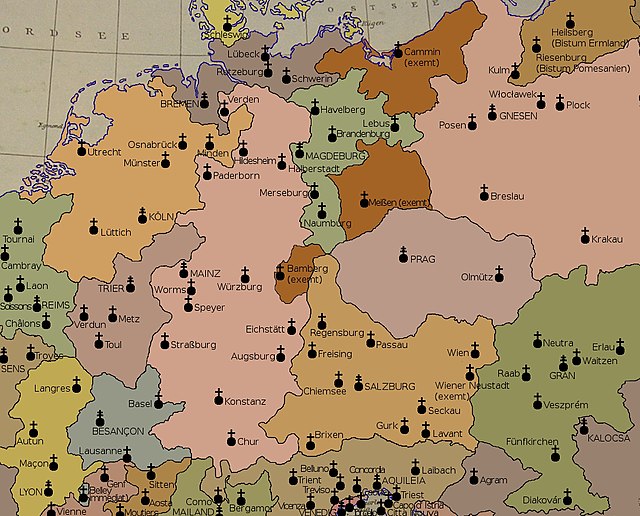Roman_Catholic_Archdiocese_of_Köln
Roman Catholic Archdiocese of Cologne
Roman Catholic ecclesiastical territory in Germany
The Archdiocese of Cologne (Latin: Archidioecesis Coloniensis; German: Erzbistum Köln) is a Latin Church archdiocese of the Catholic Church in western North Rhine-Westphalia and northern Rhineland-Palatinate in Germany.
This article needs additional citations for verification. (July 2014) |
Archdiocese of Cologne Archidioecesis Coloniensis Erzbistum Köln | |
|---|---|
 Coat of Arms of the Archdiocese of Cologne | |
| Location | |
| Country | |
| Ecclesiastical province | Cologne |
| Metropolitan | Cologne, North Rhine-Westphalia |
| Statistics | |
| Area | 6,181 km2 (2,386 sq mi) |
| Population - Total - Catholics | (as of 2021) |
| Parishes | 514 |
| Information | |
| Denomination | Roman Catholic |
| Sui iuris church | Latin Church |
| Rite | Roman Rite |
| Established | 313 |
| Cathedral | Cologne Cathedral |
| Patron saint | St. Joseph Immaculate Conception |
| Current leadership | |
| Pope | Francis |
| Archbishop | Rainer Woelki |
| Auxiliary Bishops | Dominik Schwaderlapp Ansgar Puff[1] Rolf Steinhauser |
| Vicar General | Guido Assmann |
| Map | |
 | |
| Website | |
| erzbistum-koeln.de (German) | |


At an early date Christianity came to Cologne with the Roman soldiers and traders. According to Irenaeus of Lyons, it was a bishop's see as early as the second century. However, Saint Maternus, a contemporary of Constantine I, is the first historically certain bishop of Cologne. As a result of its favourable situation, the city survived the stormy period around the fall of the Western Roman Empire. When the Franks took possession of the country in the fifth century, it became a royal residence. On account of the services of the bishops to the Merovingian kings, the city was to have been the metropolitan see of Saint Boniface, but Mainz was chosen, for unknown reasons, and Cologne did not become an archbishopric until the time of Charlemagne. The city suffered heavily from Viking invasions, especially in the autumn of 881, but recovered quickly from these calamities, especially during the reign of the Ottonian emperors.[2]
From the mid-13th century, the Electorate of Cologne—not to be confused with the larger Archdiocese of Cologne—was one of the major ecclesiastical principalities of the Holy Roman Empire. The city of Cologne as such became a free city in 1288 and the archbishop eventually moved his residence from Cologne Cathedral to Bonn to avoid conflicts with the Free City, which escaped his jurisdiction.
After 1795, the archbishopric's territories on the left bank of the Rhine were occupied by France, and were formally annexed in 1801. The Reichsdeputationshauptschluss of 1803 secularized the rest of the archbishopric, giving the Duchy of Westphalia to the Landgraviate of Hesse-Darmstadt. As an ecclesial government, however, the archdiocese remained (more or less) intact: while she lost the left bank including the episcopal city itself, Cologne, to the new Diocese of Aachen established under Napoleon's auspices, there still remained a substantial amount of territory on the right bank of the Rhine. After the death of the last Elector-Archbishop in 1801, the see was vacant for 23 years, being governed by vicar capitular Johann Herrmann Joseph v. Caspars zu Weiss and, after his death, by Johann Wilhelm Schmitz. In 1821, the archdiocese regained Cologne and the right bank of the Rhine (though with a new circumscription reflecting the Prussian subdivisions) and, in 1824, an archbishop was established there again. It remains an archdiocese to the present day, considered the most important one of Germany.
Cologne, the largest (in terms of inhabitants non-Catholics included) and reportedly richest diocese in Europe, announced in October 2013 that "in connection with the current discussion about Church finances" that its archbishop had reserves amounting to 166.2 million Euro in 2012. It said the 9.6 million Euro earnings from its investments were, as in previous years, added to the diocesan budget of 939 million Euro in 2012, three-quarters of which was financed by the "church tax" levied on churchgoers.[3] In 2015 the archdiocese for the first time published its financial accounts, which show assets worth more than £2bn. Documents posted on the archdiocesan website showed assets of €3.35bn (£2.5bn) at the end of 2013. Some € 2.4 billion (£1.8bn) were invested in stocks, funds and company holdings. A further €646m (£475m) were held in tangible assets, mostly property. Cash reserves and outstanding loans amounted to about €287m (£211m).[4]
The following is a list of the archbishops since the Archdiocese of Cologne was re-filled in 1824.
- 1824–1835: Ferdinand August von Spiegel
- 1835–1845: Clemens August von Droste-Vischering
- 1845–1864: Cardinal Johannes von Geissel
- 1866–1885: Cardinal Paul Ludolf Melchers
- 1885–1899: Cardinal Philipp Krementz
- 1899–1912: Hubert Theophil Simar
- 1902–1912: Cardinal Anton Hubert Fischer
- 1912–1919: Cardinal Felix von Hartmann
- 1920–1941: Cardinal Karl Joseph Schulte
- 1942–1969: Cardinal Josef Frings
- 1969–1987: Cardinal Joseph Höffner
- 1989–2014: Cardinal Joachim Meisner
- 2014– : Cardinal Rainer Woelki
- "Archived copy". Archived from the original on 2013-07-30. Retrieved 2013-06-14.
{{cite web}}: CS1 maint: archived copy as title (link) - Herbermann, Charles, ed. (1913). "Cologne" . Catholic Encyclopedia. New York: Robert Appleton Company.
 This article incorporates text from this source, which is in the public domain.
This article incorporates text from this source, which is in the public domain. - "Finance scandal spurs German bishops to reveal secret funds". Reuters. 16 October 2013.
- (in German) List of Bishops and Archbishops of Cologne Archdiocese of Cologne (Erzbistum Köln)
- (in English) List of Bishops and Archbishops of Cologne Cologne Cathedral (Kölner Dom)